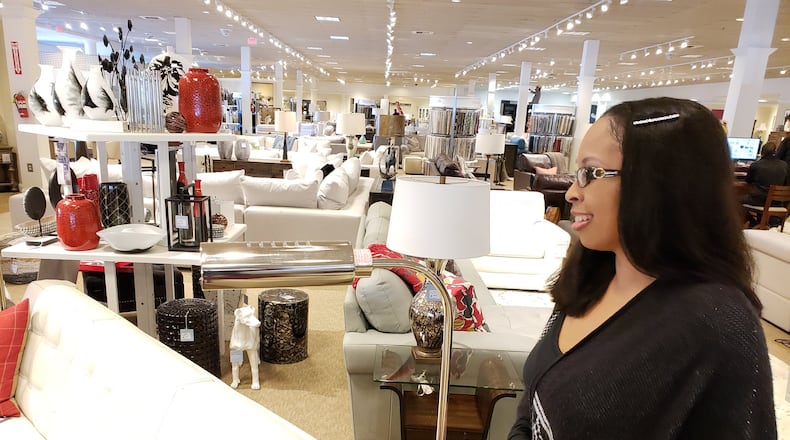Shopping in a store for a white leather sofa isn’t really in Alanna Merkerson’s comfort zone.
“I’m more comfortable getting in my bed and shopping on the internet,” she said as she toured a sprawling Havertys in Duluth with her two young kids in tow and her generous in-laws leading the way. “But things like furniture, I feel like I have to see it” in person.
These are delightful words to executives at metro-Atlanta-based Haverty Furniture Companies, who are betting physical stores will continue to be the chain’s main draw even as they beef up digital offerings. A long history is on the line, along with another test of whether retailers can weather broader changes in how Americans shop.
Havertys has survived 135 years — as of 2020 — and remains one of the nation’s oldest major retailers. It’s a profitable business, with essentially no debt, 122 stores and, remarkably, a chief executive officer who is a great grandson of Havertys’ founder.
But its sales have remained depressed in recent years and traffic in stores is down. And rivals are lurking, from Amazon to online furniture and home decor seller Wayfair to online sales of mattresses in a box.
The company, which is publicly traded, is still controlled by its founder’s family, but its hold is diminishing.
Clarence Smith, Havertys’ 68-year-old CEO, said he doesn’t see his family’s voting control ending any time soon. And he hopes it stays that way. He said he has seen private equity buyers take over furniture retailers, pull out money and load the businesses with debt.
The furniture business is tough and cyclical. There are nearly 9,000 fewer furniture stores in the nation than there were a decade ago, a 16% drop. Debt makes furniture retailers especially vulnerable, Smith said.
“We want to make damn sure that doesn’t happen to the company,” Smith said.
“I feel this is an important legacy, but also we are doing a lot of things we are very excited about,” he added later.
He and a cousin are officers in the company and sit on the board of directors. Family members hold a powerful class of shares that allows them to elect three fourths of the board and cast 10 votes per share compared with one per common share.
But a wide family tree has grown from J.J. Haverty, who opened the first store in 1885 in downtown Atlanta and had deliveries made by horse-drawn wagon. Smith declined to say how many family members have shares in the business. “Let’s put it this way: It’s five generations of Catholics.”
Just one member of the fifth generation is working at the company: a nephew leading a store in Alabama. Increasingly, some family members are selling their Class A shares and converting them to common stock to sell, Smith said.
Havertys survived the Great Depression, having gone public and landed shareholder money just three weeks before the 1929 stock market crash. In the years leading up to the Great Recession it extricated itself from heavy debt that could have swamped the company, Smith said.
Sales still haven’t fully bounced back from the last downturn. And this year the company said it was hurt by a 25% tariff on furniture products from China, which it had relied on heavily. The chain and others in the industry have shifted some work to Vietnam, but delays in getting furniture cut into sales.
Havertys has been rolling out a series of broader changes. It recently launched a buy-online-pick-up-in-store option for shoppers. Online it now offers 3-D modeling of how furniture might look in a customer’s home.
It is focusing on offering a personal touch. It provides consumers with free design consultation with no purchase required. It continues to handle its own deliveries. And the chain hired more than 100 designers to work with customers as it focused on offering more customization and special orders. That portion of the business is up.
So are Havertys’ online sales. But they make up only about 2% of of the total business. That fits with Smith’s broader contention that many furniture shoppers would rather buy in store than online.
“Our average ticket is $2,200,” Smith said. “Somebody is not going to spend that money unless they can see” the furniture and check it out in person.
The average bill at Wayfair is significantly lower, according to Havertys’ leaders. But Smith is maddened by the rise of the multibillion-dollar online retailer, which is based in Boston and markets millions of furniture, home decor and other products.
“They are taking down the perceived value,” Smith said. “They are saying you should pay $300 for a sofa and that’s what it is worth.”
Online sellers snagged some of the furniture retail industry’s fastest growth, according to trade publication Furniture Today. E-commerce accounted for about 13% of sales last year among the nation’s largest furniture retailers.
Daniel McCarthy, an Emory University marketing assistant professor, has dug into Wayfair’s model for selling furniture online. He cites problems in Wayfair’s money-losing results, even as the company’s revenues soar and prompt questions about whether furniture in general is about to see a big shift to online.
Furniture is big and bulky. That makes shipping more expensive and returns more of a challenge. It poses an extra hurdle for online-only retailers with customers who never got to touch furniture or sit on sofas before they bought them, McCarthy said.
“It is going to be a hard segment for e-commerce-only competitors to thrive in,” he said.
About the Author
Keep Reading
The Latest
Featured





